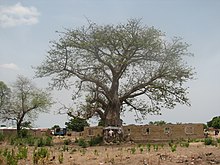
Salaga Slave Market is an 18th-century slave market located in the East Gonja District of northern Ghana. During the Trans-Atlantic slave trade, Salaga served as an important market where slaves were transported to the coast for export. [1] [2] [3] The market also served as outposts for the movement of slaves along the trans-Saharan routes. [4]
History
From the 16th century, Salaga was one of leading market centers in West Africa. [5] Kola, beads, ostrich feathers, animal hides, textiles and gold were among the goods traded in the market. [1] However, in the 18th century, the market became a key center in the trading of humans. People from the Upper west, Upper East and Northern Regions served as sources for slaves. Slaves from the market were mostly exchanged for Kola nuts, cowries and gold. [6]
See also
References
- ^ a b "Salaga Slave Market; A potential tourist site". www.graphic.com.gh. Retrieved 2019-09-27.
- ^ "Figure 3.2 'Welcome to Salaga Slave Market', Salaga (photograph:..." ResearchGate. Retrieved 2019-09-27.
- ^ "The Story of Africa| BBC World Service". www.bbc.co.uk. Retrieved 2019-09-27.
- ^ Bailey, Anne Caroline (2005). African Voices of the Atlantic Slave Trade: Beyond the Silence and the Shame. Beacon Press. ISBN 9780807055120.
- ^ Johnson, Marion (July 1986). "The Slaves of Salaga*". The Journal of African History. 27 (2): 341–362. doi: 10.1017/S0021853700036707. ISSN 1469-5138. S2CID 162923525.
- ^ "Slave Trade Program at Salaga | SYTO GHANA". www.sytoghana.org. Retrieved 2019-09-21.
External links
![]() Media related to
Salaga Slave Museum at Wikimedia Commons
Media related to
Salaga Slave Museum at Wikimedia Commons

Salaga Slave Market is an 18th-century slave market located in the East Gonja District of northern Ghana. During the Trans-Atlantic slave trade, Salaga served as an important market where slaves were transported to the coast for export. [1] [2] [3] The market also served as outposts for the movement of slaves along the trans-Saharan routes. [4]
History
From the 16th century, Salaga was one of leading market centers in West Africa. [5] Kola, beads, ostrich feathers, animal hides, textiles and gold were among the goods traded in the market. [1] However, in the 18th century, the market became a key center in the trading of humans. People from the Upper west, Upper East and Northern Regions served as sources for slaves. Slaves from the market were mostly exchanged for Kola nuts, cowries and gold. [6]
See also
References
- ^ a b "Salaga Slave Market; A potential tourist site". www.graphic.com.gh. Retrieved 2019-09-27.
- ^ "Figure 3.2 'Welcome to Salaga Slave Market', Salaga (photograph:..." ResearchGate. Retrieved 2019-09-27.
- ^ "The Story of Africa| BBC World Service". www.bbc.co.uk. Retrieved 2019-09-27.
- ^ Bailey, Anne Caroline (2005). African Voices of the Atlantic Slave Trade: Beyond the Silence and the Shame. Beacon Press. ISBN 9780807055120.
- ^ Johnson, Marion (July 1986). "The Slaves of Salaga*". The Journal of African History. 27 (2): 341–362. doi: 10.1017/S0021853700036707. ISSN 1469-5138. S2CID 162923525.
- ^ "Slave Trade Program at Salaga | SYTO GHANA". www.sytoghana.org. Retrieved 2019-09-21.
External links
![]() Media related to
Salaga Slave Museum at Wikimedia Commons
Media related to
Salaga Slave Museum at Wikimedia Commons